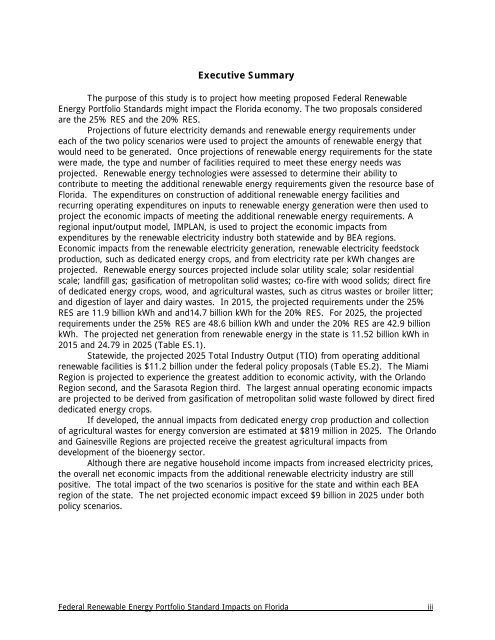Florida Study - Bipartisan Policy Center
Florida Study - Bipartisan Policy Center
Florida Study - Bipartisan Policy Center
You also want an ePaper? Increase the reach of your titles
YUMPU automatically turns print PDFs into web optimized ePapers that Google loves.
Executive SummaryThe purpose of this study is to project how meeting proposed Federal RenewableEnergy Portfolio Standards might impact the <strong>Florida</strong> economy. The two proposals consideredare the 25% RES and the 20% RES.Projections of future electricity demands and renewable energy requirements undereach of the two policy scenarios were used to project the amounts of renewable energy thatwould need to be generated. Once projections of renewable energy requirements for the statewere made, the type and number of facilities required to meet these energy needs wasprojected. Renewable energy technologies were assessed to determine their ability tocontribute to meeting the additional renewable energy requirements given the resource base of<strong>Florida</strong>. The expenditures on construction of additional renewable energy facilities andrecurring operating expenditures on inputs to renewable energy generation were then used toproject the economic impacts of meeting the additional renewable energy requirements. Aregional input/output model, IMPLAN, is used to project the economic impacts fromexpenditures by the renewable electricity industry both statewide and by BEA regions.Economic impacts from the renewable electricity generation, renewable electricity feedstockproduction, such as dedicated energy crops, and from electricity rate per kWh changes areprojected. Renewable energy sources projected include solar utility scale; solar residentialscale; landfill gas; gasification of metropolitan solid wastes; co-fire with wood solids; direct fireof dedicated energy crops, wood, and agricultural wastes, such as citrus wastes or broiler litter;and digestion of layer and dairy wastes. In 2015, the projected requirements under the 25%RES are 11.9 billion kWh and and14.7 billion kWh for the 20% RES. For 2025, the projectedrequirements under the 25% RES are 48.6 billion kWh and under the 20% RES are 42.9 billionkWh. The projected net generation from renewable energy in the state is 11.52 billion kWh in2015 and 24.79 in 2025 (Table ES.1).Statewide, the projected 2025 Total Industry Output (TIO) from operating additionalrenewable facilities is $11.2 billion under the federal policy proposals (Table ES.2). The MiamiRegion is projected to experience the greatest addition to economic activity, with the OrlandoRegion second, and the Sarasota Region third. The largest annual operating economic impactsare projected to be derived from gasification of metropolitan solid waste followed by direct fireddedicated energy crops.If developed, the annual impacts from dedicated energy crop production and collectionof agricultural wastes for energy conversion are estimated at $819 million in 2025. The Orlandoand Gainesville Regions are projected receive the greatest agricultural impacts fromdevelopment of the bioenergy sector.Although there are negative household income impacts from increased electricity prices,the overall net economic impacts from the additional renewable electricity industry are stillpositive. The total impact of the two scenarios is positive for the state and within each BEAregion of the state. The net projected economic impact exceed $9 billion in 2025 under bothpolicy scenarios.Federal Renewable Energy Portfolio Standard Impacts on <strong>Florida</strong>iii


